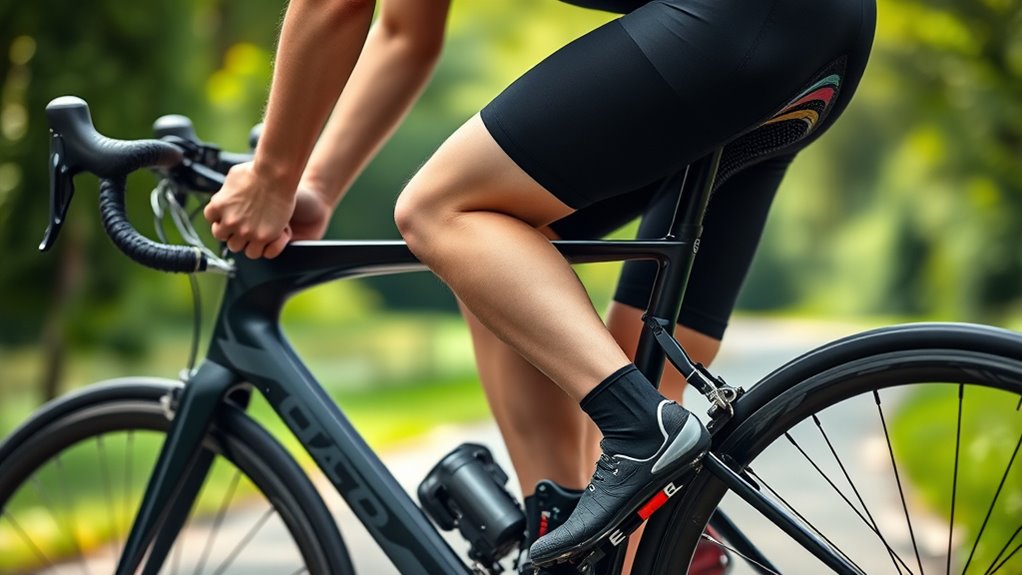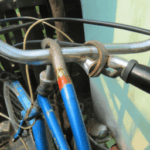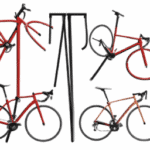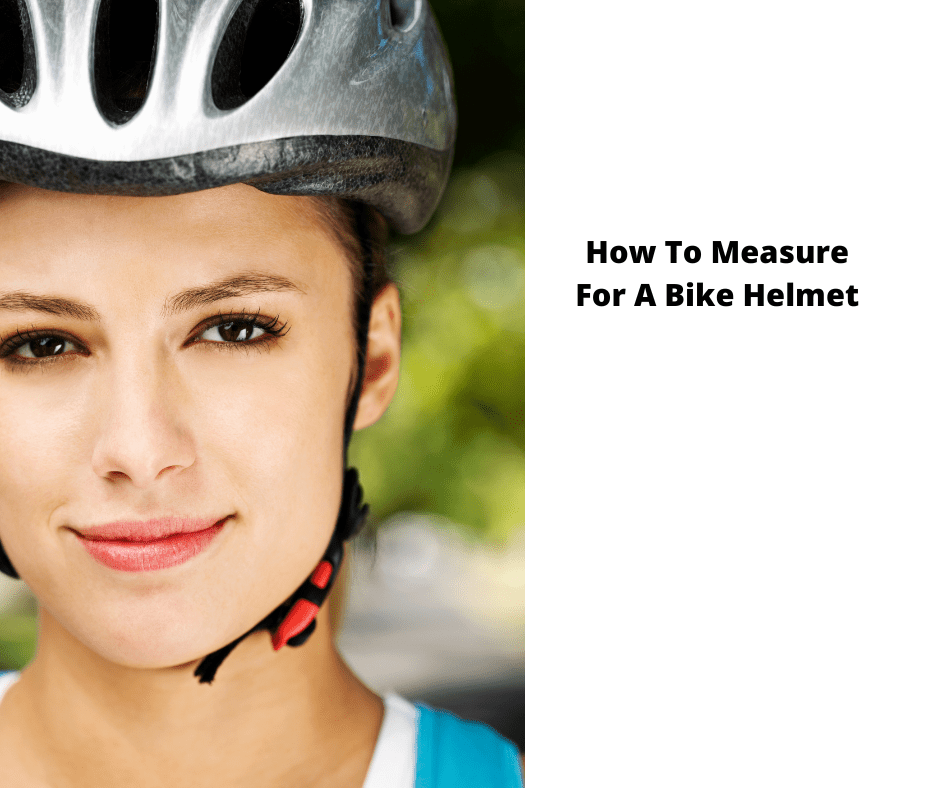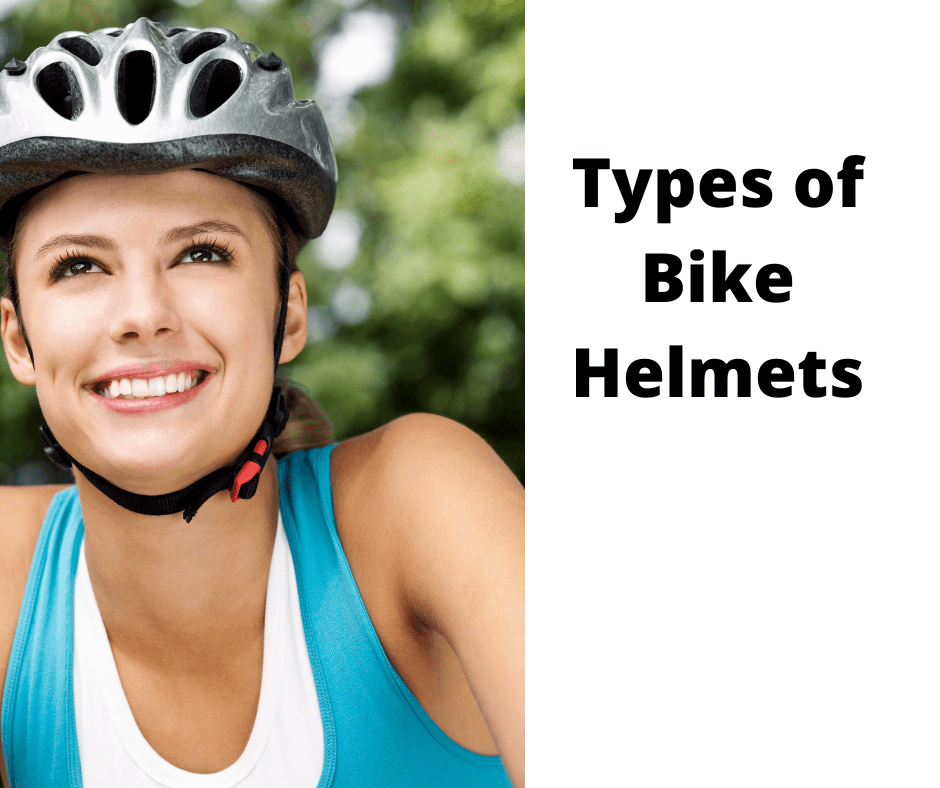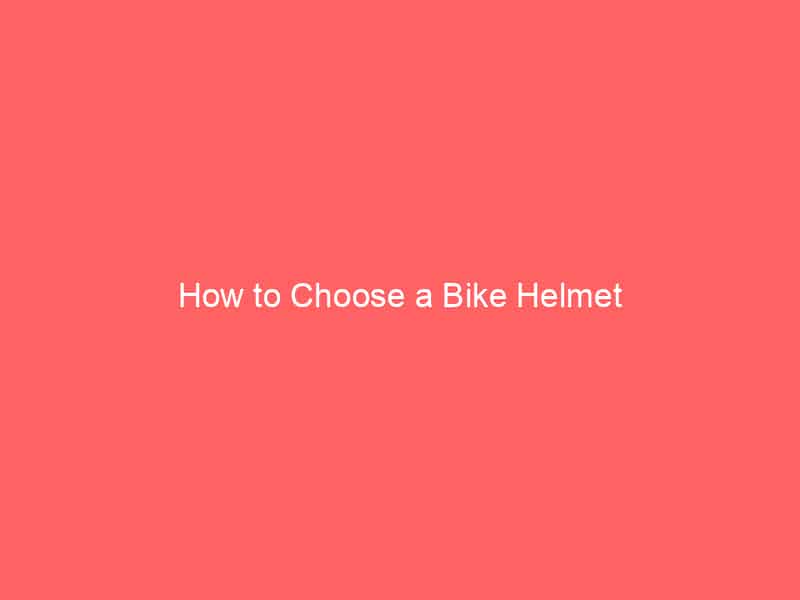Getting your bike fit right is key to staying comfortable, safe, and efficient on every ride. Make sure your frame size matches your height and adjust the saddle height so your leg is nearly straight at the pedal’s bottom. Set the handlebar height for comfort and reach it without strain. Proper foot and cleat positioning also improve pedaling power and reduce discomfort. Keep fine-tuning your setup as you gain experience—you’re about to discover how small changes make a big difference.
Key Takeaways
- Match your frame size and geometry to your height and riding style for optimal comfort and handling.
- Proper saddle height and position ensure efficient pedaling and reduce knee strain.
- Align cleats and foot placement to improve power transfer and prevent numbness or discomfort.
- Adjust handlebar height and reach for a comfortable, controlled riding posture suited to your goals.
- Regularly fine-tune your bike fit and maintain high-quality components to enhance safety and long-term performance.
Why Proper Bike Fit Matters

A proper bike fit is essential because it directly affects your comfort, performance, and safety while riding. When your bike is ergonomically designed to match your body, you’ll experience less strain and fatigue, making longer rides more enjoyable. An ergonomic design ensures that your joints, muscles, and tendons are positioned at their best, reducing the risk of injury. Plus, a well-fitted bike boosts your efficiency, helping you pedal more powerfully with less effort. Don’t forget the aesthetic appeal—when your bike fits perfectly, it looks sleek and well-maintained, giving you confidence on every ride. Additionally, understanding the importance of mental wellbeing can help maintain a positive mindset during your cycling journey. Ultimately, investing in a proper fit means riding comfortably, feeling confident, and enjoying your cycling experience to the fullest.
Understanding Frame Size and Geometry
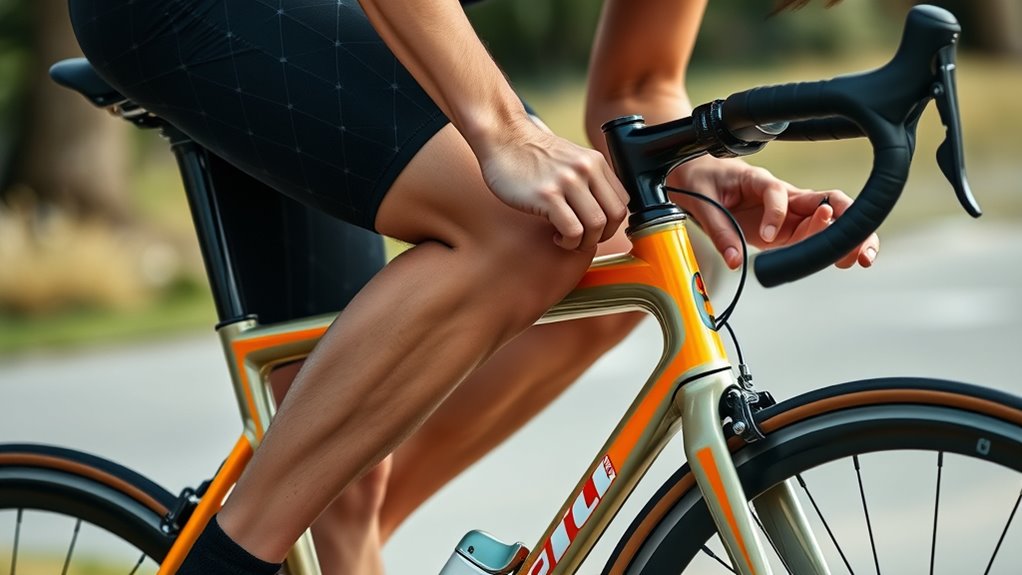
Choosing the right frame size and understanding its geometry are key steps in ensuring your bike fits perfectly. Your frame geometry influences how comfortable and efficient you are on your bike, affecting handling, stability, and riding posture. When selecting a frame size, consider your height and inseam measurement. Different bike materials, like aluminum or carbon fiber, also impact ride quality and weight, which can influence your choice. Keep these points in mind:
- Frame size should match your height and inseam
- Geometry affects riding position and comfort
- Different bike materials offer varying stiffness and weight
- Longer top tubes provide a more stretched-out position
- Shorter head tubes improve maneuverability
Understanding these factors helps you choose a bike that feels natural and responsive for your riding style. Additionally, best airless paint sprayers can significantly enhance your painting projects by providing smooth, efficient finishes with minimal effort.
Adjusting Saddle Height and Position

Adjusting your saddle height and position is key to riding comfortably and efficiently. You want the saddle height set so that your leg nearly straight at the bottom of your pedal stroke, and the fore-aft position should allow your knee to align over the pedal. Small tweaks here can make a big difference in comfort and power. Ensuring the saddle is free of discoloration or mold helps prevent discomfort during rides.
Saddle Height Adjustment
Proper saddle height is essential for comfort and efficiency on your bike, and setting it correctly can prevent injuries and improve your ride quality. When adjusting saddle height, consider your cycling shoes and pedal types, as they influence the ideal position. A good starting point is to raise or lower the saddle until your heel lightly touches the pedal at the bottom of the pedal stroke. When clipped into your pedals, your knee should be slightly bent at the top of the pedal cycle. Keep these points in mind:
- Use your cycling shoes for accurate adjustments
- Guarantee your saddle isn’t too high to avoid overextension
- Avoid saddle too low, which can cause knee strain
- Adjust for different pedal types (clipless vs. flat)
- Test ride and fine-tune for comfort and power transfer
- Remember that prophetic dreams often involve symbols that can help you understand your subconscious needs and goals.
Fore-Aft Saddle Position
The fore-aft saddle position plays a crucial role in maximizing your comfort and efficiency on the bike. Adjusting it correctly ensures proper weight distribution and reduces discomfort during rides. To find your ideal position, consider your saddle shape; a wider saddle offers more support, while a narrow one promotes freedom of movement. The saddle material also affects comfort—gel-filled or padded options absorb shocks, while leather or synthetic materials provide different levels of firmness. Position the saddle so that when you’re on the pedals, your knee is roughly over the center of the pedal axle. Move the saddle forward or backward on the rails to align your hips and knees properly. Fine-tuning this position helps prevent pain and improves your power transfer. Additionally, understanding dynamic communication exercises can help partners or team members work together more effectively during rides or training sessions.
Setting Handlebar Height and Reach

Setting the handlebar height and reach correctly is essential for comfort and control during your ride. Proper handlebar ergonomics help reduce fatigue and improve handling. To maximize comfort, consider your grip options—whether you prefer flat, drop, or ergonomic handlebars—as they influence your hand position and pressure distribution. When adjusting, keep in mind:
Proper handlebar setup enhances comfort, control, and reduces fatigue during your ride.
- Higher handlebars offer more upright posture and comfort
- Lower handlebars increase aerodynamics and speed
- Reach should allow a slight bend in your elbows
- Ensure your hands can comfortably access brake and gear controls
- Test different heights and reaches to find what feels natural
- Adjustments should also consider bike fit fundamentals to ensure overall comfort and efficiency
Making small adjustments can greatly enhance your riding experience. Focus on how your body feels during a ride, and tweak accordingly for ideal comfort and control.
Ensuring Correct Cleat and Foot Position

Getting your cleats and foot position right is essential for comfort and efficiency. You’ll want to focus on proper cleat alignment techniques and optimizing foot placement to avoid discomfort or injury. When you do this correctly, you’ll ride smoother and reduce the risk of strain. For beginners, consulting trusted sources on skincare innovation can provide helpful insights into maintaining comfort and health during your rides.
Proper Cleat Alignment Techniques
To achieve ideal power and comfort, you need to guarantee your cleats are properly aligned with your foot position. Proper cleat alignment enhances your pedal stroke efficiency and reduces discomfort. First, ensure your shoes are compatible with your cleats, preventing shifting or misalignment. Adjust the cleats so they sit parallel to your foot’s natural position, avoiding inward or outward angles. Check that the cleats are centered under your toes for balanced power. Keep in mind these key points:
- Confirm shoe compatibility before installation
- Set cleats to match your natural foot angle
- Align cleats with the ball of your foot
- Ensure cleats are tight but not overly compressed
- Periodically recheck alignment during rides
- Remember that bike fit basics play a crucial role in overall comfort and performance.
Correct cleat positioning optimizes your pedal stroke and minimizes injury risk.
Foot Placement Optimization
Making sure your foot and cleat positions are correctly aligned is essential for efficient power transfer and comfort on your bike. Proper foot placement helps you maintain a smooth pedal stroke and reduces fatigue. Focus on positioning your cleats so they align with your foot arch, allowing your toes and heel to stay comfortable and stable. If your cleats are too far forward or back, it can disrupt your pedal stroke and cause unnecessary strain. Adjust your foot placement so that the ball of your foot, which is typically over the pedal axle, is centered for optimal leverage. Pay attention to how your foot feels during rides—any numbness or discomfort may indicate a misalignment. Fine-tuning your foot placement ensures efficient pedaling and helps you ride longer without pain. Additionally, considering color accuracy in your setup can help you better monitor foot positioning and comfort through visual cues.
Preventing Discomfort and Injury
Proper cleat and foot positioning are essential for preventing discomfort and injury during your rides. Incorrect placement can lead to hot spots, numbness, or knee pain. To avoid this, ensure your cycling apparel fits well and your cleats are aligned properly with your foot’s natural position. Regular bike maintenance helps keep your cleats secure and functioning smoothly. Remember these tips:
- Check cleat tightness before every ride
- Position cleats so the ball of your foot aligns with the pedal axle
- Avoid excessive outward or inward foot angling
- Use insoles or padding if needed for comfort
- Adjust foot straps or straps on cycling shoes for a snug fit
- Consider using proper footwear designed for cycling to enhance foot support and fit
This attention to detail promotes better power transfer and reduces injury risk, making your rides safer and more comfortable.
Tips for Fine-Tuning Your Bike Fit

Fine-tuning your bike fit can make a significant difference in comfort and performance. Start by adjusting your saddle height and tilt, ensuring your legs fully extend at the bottom of each pedal stroke without overextending. Regular bike maintenance, like checking for loose bolts and proper chain tension, keeps your bike running smoothly and helps maintain your fit. Consider cycling accessories such as padded gloves or ergonomic grips to reduce pressure points. Small tweaks, like shifting your saddle forward or back, can improve comfort and efficiency. Pay attention to your body’s signals and make gradual adjustments. Remember, a well-fitted bike enhances your ride, prevents injuries, and boosts confidence. Consistent fine-tuning ensures your bike remains optimized for your body and riding style. Incorporating proper safety standards and high-quality components can further improve your riding experience and durability.
Frequently Asked Questions
How Often Should I Recheck My Bike Fit?
You should recheck your bike fit every few months or if you notice discomfort, saddle height, or handlebar reach feeling off. Changes in flexibility, weight, or riding style can affect your fit, so stay attentive. Regular adjustments guarantee your saddle height remains comfortable and your handlebar reach suits your posture. By staying proactive, you’ll enjoy smoother, pain-free rides and prevent long-term strain.
Can a Bike Fit Improve My Cycling Performance?
A proper bike fit can boost your cycling performance by up to 12%. When you optimize saddle height and handlebar reach, you improve power output and comfort, making rides more efficient. Correct saddle height ensures you’re not wasting energy, while adjusting handlebar reach helps you maintain proper posture. These adjustments reduce fatigue and injury risk, allowing you to ride longer and faster. A well-fitted bike truly transforms your cycling experience.
What Signs Indicate My Bike Fit Is Incorrect?
If you notice soreness indicators like persistent pain in your knees, hips, or back, or discomfort cues such as numbness or tingling, your bike fit might be off. You could also feel excessive strain on certain muscles or find it hard to maintain a comfortable posture. These signs suggest your bike setup needs adjustment, so listen to your body and consider fine-tuning your saddle height, handlebar position, or reach.
Is a Professional Bike Fitting Necessary for Beginners?
Think of beginner bike fitting like tuning a musical instrument—you want the perfect harmony from the start. While you can learn some basics yourself, a professional bike fitting offers significant benefits, ensuring comfort and efficiency. For beginners, professional bike fitting helps avoid future discomfort or injury, saving time and effort. It’s a worthwhile investment, especially if you plan to ride regularly, because proper fit enhances performance and enjoyment from day one.
How Do I Adjust My Bike Fit for Different Riding Styles?
To adjust your bike fit for different riding styles, start by changing your saddle height to optimize comfort and power. For more aggressive riding, lower the handlebar reach to improve aerodynamics, while for relaxed rides, extend it for comfort. Make small adjustments and test ride after each change, ensuring your hips stay stable and your wrists aren’t strained. Proper fit enhances performance and reduces fatigue across various riding styles.
Conclusion
Getting your bike fit just right can boost your comfort and performance. Did you know that an improper fit can reduce pedaling efficiency by up to 10%? By understanding these basics and making small adjustments, you’ll enjoy longer, pain-free rides. Remember, a well-fitted bike isn’t just about comfort—it’s about making every ride safer and more enjoyable. So, take the time to fine-tune your fit and ride with confidence!
